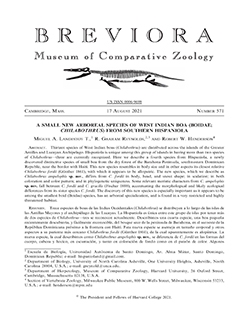Thirteen species of West Indian boas (Chilabothrus) are distributed across the islands of the Greater Antilles and Lucayan Archipelago. Hispaniola is unique among this group of islands in having more than two species of Chilabothrus—three are currently recognized. Here we describe a fourth species from Hispaniola, a newly discovered distinctive species of small boa from the dry forest of the Barahona Peninsula, southwestern Dominican Republic, near the border with Haiti. This new species resembles in body size and in other aspects its closest relative Chilabothrus fordii (Günther 1861), with which it appears to be allopatric. The new species, which we describe as Chilabothrus ampelophis sp. nov., differs from C. fordii in body, head, and snout shape; in scalation; in both coloration and color pattern; and in phylogenetic uniqueness. Some relevant meristic characters from C. ampelophis sp. nov. fall between C. fordii and C. gracilis (), accentuating the morphological and likely ecological differences from its sister species C. fordii. The discovery of this new species is especially important as it appears to be among the smallest boid (Boidae) species, has an arboreal specialization, and is found in a very restricted and highly threatened habitat.
BioOne.org will be down briefly for maintenance on 17 December 2024 between 18:00-22:00 Pacific Time US. We apologize for any inconvenience.
How to translate text using browser tools
17 August 2021
A SMALL NEW ARBOREAL SPECIES OF WEST INDIAN BOA (BOIDAE; CHILABOTHRUS) FROM SOUTHERN HISPANIOLA
Miguel A. Landestoy T.,
R. Graham Reynolds,
Robert W. Henderson
ACCESS THE FULL ARTICLE

Breviora
Vol. 571 • No. 1
August 2021
Vol. 571 • No. 1
August 2021
Caribbean
Dominican Republic
dry forest
dwarfism
phylogenetics
systematics




